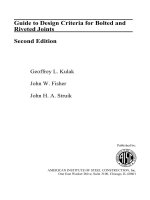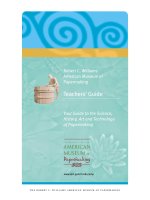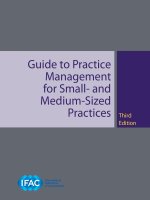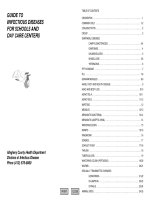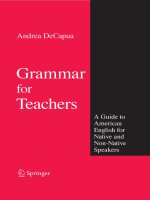Guide to Design Criteria for Bolted and Riveted Joints
Bạn đang xem bản rút gọn của tài liệu. Xem và tải ngay bản đầy đủ của tài liệu tại đây (6.63 MB, 352 trang )
Guide to Design Criteria for Bolted and
Riveted Joints
Second Edition
Geoffrey L. Kulak
John W. Fisher
John H. A. Struik
Published by:
AMERICAN INSTITUTE OF STEEL CONSTRUCTION, Inc.
One East Wacker Drive, Suite 3100, Chicago, IL 60601
Copyright (2001) by the Research Council on Structural Connections.
All rights reserved.
Original copyright (1987) by John Wiley & Sons, Inc. transferred to RCSC.
Reproduction or translation of any part of this work beyond that permitted by Section
107 or 108 of the 1976 United States Copyright Act without the permission of the
copyright owner is unlawful. Requests for permission or further information should be
addressed to RCSC c/o AISC, One East Wacker Drive, Suite 3100, Chicago, IL 60601.
Library of Congress Cataloging in Publication Data:
Fisher, John W., 193 1Guide to design criteria for bolted and riveted joints.
“A Wiley-lnterscience publication.” Bibliography: p.
Includes index.
1. Bolted joints. 2. Riveted joints. I. Kulak, Geoffrey. II. Struik, John H. A., 1942-
III. Title.
TA492.B63F56 1987671.5 86-22390
ISBN 0-471-83791-1 (for Wiley copyright) ISBN 1-56424-075-4 (for RCSC copyright)
Printed in the United States of America
10 9 8 7 6
Foreword
Since the first edition of this book was published in 1974, numerous international
studies on the strength and performance of bolted connections have been conducted. Ln
the same period, the Research Council on Structural Connections has developed two
new specifications for structural joints using ASTM A325 or A490 bolts, one based on
allowable stress principles and the other on a load factor and resistance design
philosophy. In addition, the Research Council has approved and published “A Test
Method to Determine the Slip Coefficient for Coatings used in Bolted Joints.” This
second, updated, edition has been prepared and approved by the Research Council.
Formed in 1947 and formerly known as the Research Council on Riveted and
Bolted Structural Connections, the Research Council on Structural Connections is a
nonprofit technical body composed of consulting engineers, educational institutions
trade associations and government agencies, and individual members. Its membership
is classified according to interest either as producers, users, or general interest, and its
purpose is to promote technical information and the knowledge of economical, efficient
and safe practices related to the design and installation of bolted structural connections.
The Research Council’s Specifications have been endorsed by the Industrial
Fasteners Institute and endorsed and published by the American Institute of Steel
Construction, and they form the basis of the technical requirements of other national
standards.
Research Council on
Structural Connections
Preface
The impetus for the preparation of a second edition of the Guide to Design Criteria for
Bolted and Riveted Joints has been the enthusiastic reception of the original version
and the continued citation for over a decade of that book as a source of information
regarding the design of bolted connections. There certainly has been no other single
reference in this area that has been so accepted by designers, teachers, students, and
specification writers.
Of course, a great deal of research into the behavior of bolted connections has been
conducted since the publication of the original Guide. Indeed, that publication itself
identified areas of concern and areas in which information was lacking, and it thereby
stimulated research. The success of the original Guide and the amount of significant
research that has been done since its publication indicated that a revised and updated
version was desirable. The authors are grateful to the Research Council on Structural
Connections for supporting the preparation Of a second edition and for underwriting
the costs involved. Many council members offered suggestions, and the efforts of the
council were coordinated by M. I. Gilmor of the Canadian Institute of Steel
Construction. Geoffrey Kulak also particularly wishes to express thanks to Professor J.
-C. Badoux, Director of ICOM (Institute de la Construction Mdtallique) at École
Polytechnique Federale de Lausanne in Switzerland. The majority of the revisions
contained in the second edition were prepared while that author was a visiting professor
at the Institute.
Readers of the original Guide will find that the second edition follows the same
framework. After introductory chapters treating the historical background of high-
strength bolts and rivets, the behavior of individual fasteners is introduced. This is
followed by descriptions of the behavior of fasteners in the various types of
connections that are encountered in structural engineering practice. Throughout the
book, new data have been used to update the information originally presented or to
present thoughts in areas that were not covered at all in the earlier edition. There has
been a great deal of new work for the authors to draw on. For example, there have been
significant improvements in our knowledge of the behavior of slip-resistance
connections, fatigue of bolted and riveted connections, beam-to-column connections,
and so on. The authors are grateful to researchers throughout the world who have
shared their results so willingly.
GEOFFREY
L.
KULAK
JOHN
W.
FISHER
JOHN
H. A.
STRUIK
Edmonton, Alberta, Canada
Bethlehem, Pennsylvania
January 1987
vii
Preface to First Edition
This book provides a state-of-the-art summary of the experimental and theoretical
studies undertaken to provide an understanding of the behavior and strength of riveted
and bolted structural joints. Design criteria have been developed on the basis of this
information and should be beneficial to designers, teachers, students, and specification-
writing bodies.
The book is intended to provide a comprehensive source of information on bolted
and riveted structural joints as well as an explanation of their behavior under various
load conditions. Design recommendations are provided for both allowable stress design
and load factor design. In both cases, major consideration is given to the fundamental
behavior of the joint and its ultimate capacity.
The work on this manuscript was carried out at Fritz Engineering Laboratory,
Lehigh University, Bethlehem, Pa. The Research Council on Riveted and Bolted
Structural Joints sponsored the project from its inception in 1969.
The work has been guided by the Councils Committee on Specifications under the
chairmanship of Dr. Theodore R. Higgins. Other members of the committee include: R.
S. Belford, E. Chesson, Jr., M. F. Godfrey, F. E. Graves, R. M. Harris, H. A. Krentz, F.
R. Ling, W. H. Munse, W. Pressler, E. J. Ruble, J. L. Rumpf, T. W. Spilman, F. Stahl,
and W. M. Thatcher. The authors are grateful for the advice and guidance provided by
the committee. Many helpful suggestions were made during the preparation of the
manuscript. Sincere appreciation is also due the Research Council on Riveted and
Bolted Structural Joints and Lehigh University for supporting this work.
A book of this magnitude would not have been possible without the assistance of
the many organizations who have sponsored research on riveted and bolted structural
joints at Fritz Engineering Laboratory. Much of the research on the behavior of riveted
and bolted structural joints that was conducted at Fritz Engineering Laboratory
provided background for this study and was drawn on extensively. Those sponsoring
this work include the American Institute of Steel Construction, the Pennsylvania
Department of Transportation, the Research Council on Riveted and Bolted Structural
Joints, the United States Department of Transportation-Federal Highway
Administration, and the Louisiana Department of Transportation.
The authors are particularly grateful for the advice provided by Dr. Theodore R.
Higgins and Dr. Geoffrey L. Kulak. Many helpful suggestions were provided that
greatly improved the manuscript and design recommendations.
ix
x Preface to First Edition
The manuscript was typed by Mrs. Charlotte Yost, and her assistance with the
many phases of the preparation of the manuscript is appreciated. Acknowledgment is
also due Mary Ann Yost for her assistance with the preparation of the various indexes
provided in this book and other resource material. Many organizations have given
permission
to reproduce graphs, tables, and photographs. This permission is
appreciated and
credit is given at the appropriate place.
JOHN W. FISHER
JOHN H. A.
STRUIK
Bethlehem, Pennsylvania
July 1973
Contents
1. Introduction 1
1.1 Purpose and Scope, 1
1.2 Historical Notes, 1
1.3 Types and Mechanical Properties of Structural Fasteners, 3
2. General Provisions 9
2.1 Structural Steels, 9
2.2 Types of Connections, 12
2.3 Loads, 16
2.4 Factor of Safety—Load Factor Design, 17
2.5 Bolted and Riveted Shear Splices, 18
2.6 Fatigue, 20
2.7 Fracture, 22
3. Rivets 27
3.1 Rivet Types, 27
3.2 Installation of Rivets, 27
3.3 Behavior of Individual Fasteners, 29
3.3.1 Rivets Subjected to Tension, 29
3.3.2 Rivets Subjected to Shear, 30
3.3.3 Rivets Subjected to Combined Tension and Shear, 31
3.4 Basis for Design Recommendations, 33
3.4.1 Rivets Subjected to Tension, 33
3.4.2 Rivets Subjected to Shear, 33
3.4.3 Rivets Subjected to Combined Tension and Shear, 33
xi
xii Contents
4. Bolts 35
4.1 Bolt Types, 35
4.2 Behavior of Individual Fasteners, 39
4.2.1 Bolts Subjected to Tension, 39
4.2.2 Bolts Subjected to Shear, 44
4.2.3 Bolts Subjected to Combined Tension and Shear, 50
4.3 Installation of High-Strength Bolts, 52
4.4 Relaxation, 61
4.5 Reuse of High-Strength Bolts, 62
4.6 Galvanized Bolts and Nuts, 63
4.7 Use of Washers, 65
4.8 Corrosion and Embrittlement, 66
4.9 Effect of Nut Strength, 69
4.10 Basis for Design Recommendations, 70
4.10.1 Bolts Subjected to Tension, 70
4.10.2 Bolts Subjected to Shear, 71
4.10.3 Bolts Subjected to Combined Tension and Shear, 71
5. Symmetric Butt Splices 74
5.1 Joint Behavior up to Slip, 74
5.1.1 Introduction, 74
5.1.2 Basic Slip Resistance, 74
5.1.3 Evaluation of Slip Characteristics, 75
5.1.4 Effect of Joint Geometry and Number of Faying Surfaces, 77
5.1.5 Joint Stiffness, 78
5.1.6 Effect of Type of Steel, Surface Preparation, and Treatment on
the Slip Coefficient, 78
5.1.7 Effect of Variation in Bolt Clamping Force, 82
5.1.8 Effect of Grip Length, 89
5.2 Joint Behavior After Major Slip, 89
5.2.1 Introduction, 89
5.2.2 Behavior of Joints, 89
5.2.3 Joint Stiffness, 94
5.2.4 Surface Preparation and Treatment, 94
5.2.5 Load Partition and Ultimate Strength, 95
5.2.6 Effect of Joint Geometry, 99
5.2.7 Type of Fastener, 109
5.2.8 Effect of Grip Length, 111
5.2.9 Bearing Stress and End Distance, 112
Contents xiii
5.3 Joint Behavior Under Repeated Loading, 116
5.3.1 Basic Failure Modes, 116
5.3.2 Fatigue Strength of Bolted Butt Joints, 118
5.4 Design Recommendations, 126
5.4.1 Introduction, 126
5.4.2 Design Recommendations—Fasteners, 128
5.4.3 Design Recommendations—Connected Material, 138
5.4.4 Design Recommendations for Bearing Stresses, 143
6. Truss-Type Connections 148
6.1 Introduction, 148
6.2 Behavior of Truss-Type Connections, 148
6.2.1 Static Loading, 148
6.2.2 Repeated Loading, 155
6.3 Design Recommendations, 156
7. Shingle Joints 158
7.1 Introduction, 158
7.2 Behavior of Shingle Joints, 158
7.3 Joint Stiffness, 162
7.4 Load Partition and Ultimate Strength, 162
7.5 Effect of Joint Geometry, 163
7.5.1 Effect of Variation in A
n
/A
s
Ratio and Joint Length, 163
7.5.2 Number of Fasteners per Region, 163
7.5.3 Number of Regions, 164
7.6 Design Recommendations, 165
7.6.1 Approximate Method of Analysis, 165
7.6.2 Connected Material, 170
7.6.3 Fasteners, 170
8. Lap Joints 171
8.1 Introduction, 171
8.2 Behavior of Lap Joints, 171
8.3 Design Recommendations, 174
8.3.1 Static Loading Conditions, 175
8.3.2 Repeated-Type Loading, 175
xiv Contents
9. Oversize and Slotted Holes 176
9.1 Introduction, 176
9.2 Effect of Hole Size on Bolt Tension and Installation, 176
9.3 Joint Behavior, 180
9.3.1 Slip Resistance, 180
9.3.2 Ultimate Strength, 183
9.4 Design Recommendations, 183
10. Filler Plates between Surfaces 186
10.1 Introduction, 186
10.2 Types of Filler Plates and Load Transfer, 186
10.3 Design Recommendations, 192
11. Alignment of Holes 194
11.1 Introduction, 194
11.2 Behavior of Joints with Misaligned Holes, 194
11.3 Design Recommendations, 196
12. Surface Coatings 197
12.1 Introduction, 197
12.2 Effect of Type of Coating on Short-Duration Slip Resistance, 198
12.2.1 Hot-Dip Galvanizing, 198
12.2.2 Metallizing, 202
12.2.3 Zinc-Rich Paints, 202
12.2.4 Vinyl-Treated Surfaces, 206
12.3 Joint Behavior Under Sustained Loading, 208
12.4 Joint Behavior Under Repeated Loading, 210
12.5 Design Recommendations, 212
13. Eccentrically Loaded Joints 217
13.1 Introduction, 217
13.2 Behavior of a Fastener Group Under Eccentric Loading, 218
13.3 Analysis of Eccentrically Loaded Fastener Groups, 220
13.3.1 Slip-Resistant Joints, 221
13.3.2. Ultimate Strength Analysis, 223
Contents xv
13.4 Comparison of Analytical and Experimental Results, 225
13.5 Design Recommendations, 227
13.5.1 Connected Material, 227
13.5.2 Fasteners, 227
14. Combination Joints 232
14.1 Introduction, 232
14.2 Behavior of Combination Joints That Share Load on a Common Shear
Plane, 234
14.2.1 High-Strength Bolts Combined with Welds, 235
14.2.2 High-Strength Bolts Combined with Rivets, 238
14 3 Design Recommendations 240
14.3.1 Static Loading Conditions, 241
14.3.2 Repeated Loading Conditions, 241
15. Gusset Plates 243
15.1 Introduction, 243
15.2 Method of Analysis and Experimental Work on Gusset Plates, 244
15.3 Design Recommendations, 253
16. Beam and Girder Splices 255
16.1 Introduction, 255
16.2 Types and Behavior of Beam-Girder Splices, 255
16.2.1 Flange Splices, 257
16.2.2 Web Splices, 259
16.3 Design Recommendations, 261
16.3.1 Flange Splices, 261
16.3.2 Web Splices, 262
17. Tension-Type Connections 263
17.1 Introduction, 263
17.2 Single Fasteners in Tension, 263
17.3 Bolt Groups Loaded in Tension—Prying Action, 266
17.4 Repeated Loading of Tension-Type Connections, 272
17.5 Analysis of Prying Action, 274
xvi Contents
17.6 Design Recommendations, 282
17.6.1 Static Loading, 282
17.6.2 Repeated Loading, 286
18. Beam-to-Column Connections 289
18.1 Introduction, 289
18.2 Classification of Beam-to-Column Connections, 290
18.3 Behavior of Beam-to-Column Connections, 292
18.3. 1 Flexible Beam-to-Column Connections, 293
18.3.2 Semi-Rigid Connections, 300
18.3.3 Rigid Connections, 301
18.4 Stiffener Requirements for Bolted Beam-to-Column
Connections, 313
18.5 Design Recommendations, 317
Author Index 323
Subject Index 329
Chapter One
Introduction
1.1 PURPOSE AND SCOPE
The purpose of this book is to provide background information and criteria that can
be used as a guide to the improvement of existing design procedures and
specifications for bolted and riveted joints. To achieve this goal, extensive research
work performed in the United States, Canada, Australia, Germany, the Nether-
lands, England, Norway, Japan, and elsewhere was reviewed.
Among the criteria considered as a basis for design was an evaluation of the
load versus deformation characteristics of the component parts of the joint. The
major emphasis was placed on the behavior of structural joints connected by
ASTM A325 or A490 high-strength bolts. The joint materials considered ranged
from structural carbon steel with a specified yield stress between 33 and 36 ksi
(227 and 248 MPa) to quenched and tempered alloy steel with a yield stress
ranging from 90 to 100 ksi (620 to 689 MPa).
The different types of fasteners, connections, loading conditions, and design
procedures are discussed briefly in the first two chapters. Chapters 3 and 4 deal
with the behavior of individual fasteners under various loading conditions.
Chapter 5 describes the behavior, analysis, and design of symmetric butt splices.
Special types of joints such as truss-type connections, shingle joints, beam or
girder splices, and beam-to-column connections are discussed in subsequent
chapters.
1.2 HISTORICAL NOTES
Rivets were the principal fasteners in the early days of iron and steel, but occa-
sionally bolts of mild steel were used in structures.
1.6, 1.8
It had long been known
that hot-driven rivets generally produced clamping forces. However, the axial
force was not controlled and varied substantially. Therefore, it could not be
evaluated for design.
Batho and Bateman were the first to suggest that high-strength bolts could be used
to assemble steel structures.
1.1
In 1934 they reported to the Steel Structures Committee
of Scientific and Industrial Research of Great Britain that bolts could
2 Introduction
be tightened enough to prevent slip in structural joints. It was concluded that bolts
with a minimum yield strength of 54 ksi could be tightened sufficiently to give an
adequate margin of safety against slippage of the connected parts.
Based on tests performed at the University of Illinois, Wilson and Thomas
reported
1.2
in 1938:
The fatigue strength of high-strength bolts appreciably smaller than the holes
in the plates was as great as that of well driven rivets if the nuts were screwed
up to give a high tension in the bolt.
Little more was done about high-strength bolting until 1947 when the Research
Council on Riveted and Bolted Structural Joints (RCRBSJ) was formed. The
purpose of the council, known now as the Research Council on Structural
Connections (RCSC), was as follows:
To carry on investigations as may seem necessary to determine the suitability of
various types of joints used in structural frames.
The council sponsored studies on high-strength bolts and rivets and their use in
structural connections. The realization that bolts could be extremely useful in the
maintenance of bridges helped support developmental work at this early stage. The
use of high-strength steel bolts as permanent fasteners has become general since
the formation of the RCRBSJ. Prior to that time heat-treated carbon bolts were
only used for fitting-up purposes and for carrying the loads during erection. The
bolts were tightened to pull the plies of joint material together, but no attempt was
made to attain a precise amount of clamping force.
The American Society for Testing and Materials (ASTM) in conjunction with
the RCRBSJ prepared a tentative specification for the materials for high-strength
bolts, a specification which was first approved in l949.
1.3
Using the results of
research, the RCRBSJ prepared and issued its first specification for structural
joints using high-strength bolts in January 1951.
1.4
This specification permitted the
rivet to be replaced by a bolt on a one-to-one basis.
In the early 1950s, the installation procedures, the slip resistance of joints
having different surface treatments, and the behavior of joints under repeated
loadings were studied.
1.6
Outside of the United States high-strength bolts also
attracted much attention. Sufficient experience was gained in the laboratory and in
bridge construction to enable the German Committee for Structural Steelwork
(GCSS) to issue a preliminary code of practice (1956).
1.7
In Great Britain, the
general practice was similar to practice and specifications in the United States. The
British Standards Institution issued a British Standard (BS) 3139 dealing with bolt
material in 1959. In 1960, BS 3294 was issued to establish the design procedure
and field practice.
Research developments led to several editions of the RCRBSJ specifications.
Allowable stresses were increased, tightening procedures were modified, and new
developments such as the use of A490 alloy steel bolts, galvanized joints and bolts,
and slotted holes were incorporated.
1.4
The first edition of the Guide to Design
1.3 Types and Mechanical Properties of Structural Fasteners 3
Criteria for Bolted and Riveted Connections,
1.13
sponsored by the council and
published in 1974, provided a valuable summary of connection and connector
behavior for designers and specification writers alike. The presentation of the
strength and deformation statements in their most fundamental and basic forms
made the guide directly useful for those using the limit states design formats that
emerged in the late 1970s.
1.3 TYPES AND MECHANICAL PROPERTIES OF STRUCTURAL
FASTENERS
The mechanical fasteners used in structural connections can be classified as either
rivets or bolts. Both serve the same purpose, but there are significant differences in
appearance. Standards for both types of fasteners are given in Ref. 1.5.
The most commonly used types of structural bolts are (1) the ASTM A307
grade A carbon steel bolt, (2) the ASTM A325 high-strength steel bolt, and (3) the
ASTM A490 quenched and tempered alloy steel.
1.3, 1.9, 1.10
The ASTM low carbon steel fastener is primarily used in light structures,
subjected to static loads. The high-strength A325 and A490 bolts are heavy hex
structural bolts used with heavy hex nuts (see Fig. 1.1).
A307 bolts are made of low carbon steel with mechanical properties as
designated by ASTM A307. A325 bolts are made by heat-treating, quenching, and
tempering medium carbon steel. Two different strength levels are specified,
depending on the size of the bolts (see Fig. 1.2).
1.3
The quenched and tempered
alloy steel bolt, designated as the A490 bolt, has higher mechanical properties as
compared with the A325 high-strength bolt. It was especially developed for use with
high-strength steel members. The A490 specification calls for the heavy head and
Fig. 1.1. Heavy hex bolts. (a) High-strength bolt (Courtesy of Bethlehem Steel Corp.); (b)
installed bolt.
4 Introduction
ASTM designation Bolt diameter (in.) Tensile strength
a
(ksi)
A307-83a All 60 minimum
A325-84 ½ -1 120 minimum
1
1/8
– 1 ½ 105 minimum
A490k-84 ½ - 1 ½ 150 minimum – 170
minimum
Fig 1.2 Tensile strength requirements of structural bolts.
a
Computed on the stress area.
the short thread length of the A325 specification together with chemical and
physical properties nearly identical to the A354 grade BD bolt.
1.11
For the
development of the A490 bolt many calibration tests were performed on A354
grade BD fasteners manufactured to conform to the A490 specification
requirements. The mechanical properties of the different bolt types for structural
joints are summarized in Figs.1.2 and 1.3. Unlike rivets, the strength of bolts is
specified in terms of a tensile test of the threaded fastener. The load versus
elongation characteristics of a bolt are more significant than the stress versus strain
diagram of the parent metal because performance is affected by the presence of the
threads. Also, the stress varies along the bolt as a result of the gradual introduction
of force from the nut and the change in section from the threaded to the unthreaded
portion. The weakest section of any bolt in tension is the threaded portion. The
tensile strength of the bolt is usually determined from the “stress area,” defined
using U.S. Customary Units as:
2
n
0.9743
–D 785.0area stress
=
Fig 1.3 Coupon stress versus strain relationships for different fastener materials.
1.3 Types and Mechanical Properties of Structural Fasteners 5
where D = nominal bolt diameter
n = number of threads per inch
Figure 1.4 shows typical load versus elongation curves for three different bolts of
the same diameter. The tensile strength of each of the bolts was near its specified
minimum.
In addition to regular structural bolts, threaded parts have many other
structural applications, for example, anchor bolts or tension rods. Anchor bolts are
used in column base plates to prevent the uplift of the base plate due to column
moments. Threaded parts in tension rods are frequently used to transmit tensile
loads from one element to another. In all of these applications, the threaded parts
are primarily subjected to tensile loads, and the ultimate tensile load of these
connections is determined on the basis of the stress area.
The nut is an important part of the bolt assembly. Nut dimensions and
strengths are specified so that the strength of the bolt is developed.
1.5
Bolts are generally used in holes 1/16 in. (2 mm) larger than the nominal bolt
diameter. When A307 or other mild steel bolts are used, the connection is
commonly in bearing, and the nuts are tightened sufficiently to prevent play in the
connected members. The clamping force is not very great and should not be
considered to have any influence on either the fastener or connection behavior.
High-strength bolts (A325 and A490) can produce high and consistent preloads.
The RCSC specification requires that they be tightened to at least 70% of the
specified minimum tensile strength of the bolt material. The tension is obtained as
the nut is turned against the gripped material. Such tightening requires the use of
hand torque wrenches or powered impact wrenches. Two methods of controlling
bolt
Fig 1.4 Comparison of bolt types (direct tension).
Fig. 1.5. Rivets. (a) Rivet types (Courtesy of Bethlehem Steel Corp.); (b) installed rivet.
6
References 7
Grade 1 Grade 2 Grade 3
Min. Max. Min. Max. Min. Max.
Rockwell B
Brinell, 500-kgf load, 10-mm ball
55
103
72
126
76
137
85
163
76
137
93
197
Fig. 1.6 Hardness requirements for A502 rivet steel
tension are used. A detailed description of both tightening procedures is given in
Chapter 4.
Rivets are made from bar stock by either hot- or cold-forming the
manufactured head. The head is usually of the high button-type, although flattened
and counter-sunk rivets are made for applications with limited clearance. Different
rivet types are shown in Fig. 1.5.
Structural rivet steels are of three types: (1) ASTM A502 grade 1, carbon rivet
steel, (2) ASTM A502 grade 2, high-strength structural steel rivets, and ASTM
A502 grade 3, similar to grade 2 but with enhanced atmospheric corrosion
resistance
1.12
. Grade 1 and 2 rivets correspond to those formerly made from steel
conforming to ASTM A141 and A195, respectively. Grade 3 rivets are made from
steel conforming to ASTM A588. The mechanical hardness requirements for A502
rivet steel are listed in Fig. 1.6. The stress versus strain relationships for typical,
undriven A502 rivets are given in Fig. 1.3. For comparative purposes this figure
also shows the stress versus strain curves obtained from 0.505-in, diameter
specimens turned from full-size A325 and A490 bolts. In North America, rivets are
now seldom used in new work. Bolts, either ordinary (A307) or high-strength
(A325 and A490), provide an equal or superior connection, and their installed cost
is less than that of rivets.
REFERENCES
1.1 C. Batho and E. H. Bateman, Investigations on Bolts and Bolted Joints, second report of
the Steel Structures Research Committee, London, 1934.
1.2 W. M. Wilson and F. P. Thomas, Fatigue Tests on Riveted Joints, Bulletin 302,
Engineering Experiment Station, University of Illinois, Urbana, 1938.
1.3 American Society for Testing and Materials, High-Strength Bolts for Structural Steel
Joints, ASTM Designation A325-84 (originally issued 1949), Philadelphia, 1985.
1.4 Research Council on Riveted and Bolted Structural Joints of the Engineering
Foun
dation, Specifications for Assembly of Structural Joints Using High-
Strength Bolts, originally issued 1951, latest edition; Research Council on
Structural Connections, Specification for Structural Joints Using ASTM A325 or
A490 Bolts, 1985.
1.5 Industrial Fasteners Institute, Fastener Standards, 5
th
ed., Industrial Fasteners Institute,
Cleveland, Ohio, 1970.
8 Introduction
1.6 ASCE-Manual 48, Bibliography on Bolted and Riveted Joints, Headquarters of the
Society, New York. 1967.
1.7 Deutscher Stahlbau-Verband, Preliminary Directives for the Calculation, Design and
Assembly of Non-Slip Bolted Connections, Stahlbau Verlag, Cologne, 1956.
1.8 A. E. R. de Jonge, Bibliography on Riveted Joints, American Society of Mechanical
Engineers, New York, 1945.
1.9 American Society for Testing and Materials, Heat-Treated Steel Structural Bolts,
150
ksi Minimum Tensile Strength, ASTM Designation A490-84, Philadelphia,
1985.
1.10 American Society for Testing and Materials, Carbon Steel Externally Threaded
Standard Fasteners, ASTM Designation A307-83a, Philadelphia, 1983.
1.11 American Society for Testing and Materials, Quenched and Tempered Alloy Steel
Bolts, Studs and Other Externally Threaded Fasteners, ASTM Designation
A354-84b, Philadelphia, 1985.
1.12 American Society for Testing and Materials, Steel Structural Rivets, ASTM
Designation A502-83a, Philadelphia, 1985.
1.13 J. W. Fisher and J. H. A. Struik, Guide to Design Criteria for Bolted and Riveted
Connections, Wiley, New York, 1974.
Chapter Two
General Provisions
2.1 STRUCTURAL STEELS
Knowledge of the material properties is a major requirement for the analysis of any
structural system. The strength and ductility of a material are two characteristics
needed by the designer. These material properties are often described adequately by
the stress versus strain relationship for the material. Figure 2.1 shows the stress
versus strain relationship that is characteristic of many steels for structural
applications. The figure shows the four typical ranges of behavior: the elastic
range, the plastic range (during which the material flows at a constant stress), the
strain-hardening range, and the range during which necking occurs, terminating in
fracture. Generally the initial elastic and yield segments are the most important
portions. The following points can be noted in Fig. 2.1:
1. Over an initial range of strain, stress and strain are proportional. The slope
of the linear relationship is Young’s modulus, E.
2. After the initiation of yield there is a flat plateau. The extent of the yield
zone (or “plastic range”) can be considerable.
3. At the end of the plateau, strain-hardening begins, with a subsequent increase
in strength.
Structural steel can undergo sizeable permanent (plastic) deformations before
fracture. In contrast to a brittle material, it will generally show signs of distress
through permanent, but noncatastrophic, plastic deformation. The energy absorbed
during the process of stretching is proportional to the area under the stress versus
strain curve. The ductility is essential in various ways for the proper functioning of
steel structures and is particularly important in the behavior of connections.
Structural steels can be classified as follows:
1. Structural carbon steel with a specified yield stress between 33 and 36 ksi
(228 and 248 MPa). Typical examples are A36 and Fe37 steels.
9
10 General Provisions
Fig. 2.1. Stress versus strain curve. (a) Stress versus strain curve for structural carbon steel;
(b) initial portion of stress versus strain curve.
2. High-strength steel with a specified yield stress between 42 and 50 ksi
(290 and 345 MPa). A typical example in this category is A588 steel.
3. High-strength low-alloy steels with a specified yield stress ranging from
40 to 65 ksi (276 to 448 MPa). This category comprises steels such as
A242, A441, A572, A588, and Fe52.
4. Quenched and tempered carbon steel with a specified yield stress between
50 and 60 ksi (345 and 414 MPa). A537 steel is a typical example.
General Provisions 11
Fig 2.2 Typical stress versus strain curves for structural steels.
5. Quenched and tempered alloy steel with a specified yield stress ranging
from 90 to 100 ksi (621 to 689 MPa). Materials in this category are
covered by ASTM A514 and A517.
Typical stress versus strain curves for these steels are given in Fig. 2.2. The
curves shown are for steels having specified minimum tensile properties. The
corresponding properties of these steels are listed in Fig. 2.3.
Steel Type
Minimum Yield
Stress (ksi)
Tensile Strength
(ksi)
Minimum
Elongation
In 8 in.
b
(%)
A36-84a
A242-84
A441-84
A572-84
A588-84
A537-84
A514-84a
36
42-50
a
40-50
a
42-65
a
42-50
a
45-60
a
90-100
a
58-80
63-70
a
60-70
a
60-80
a
63-70
a
70-100
a
100-130
a
20
18
18
15-20
a
18
18-22
a
17-18
a
Fig 2.3 Minimum specified properties for structural steels.
a
Depending of thickness.
b
2 in.
for A514 Steel and for A537 Class 2 steel.
